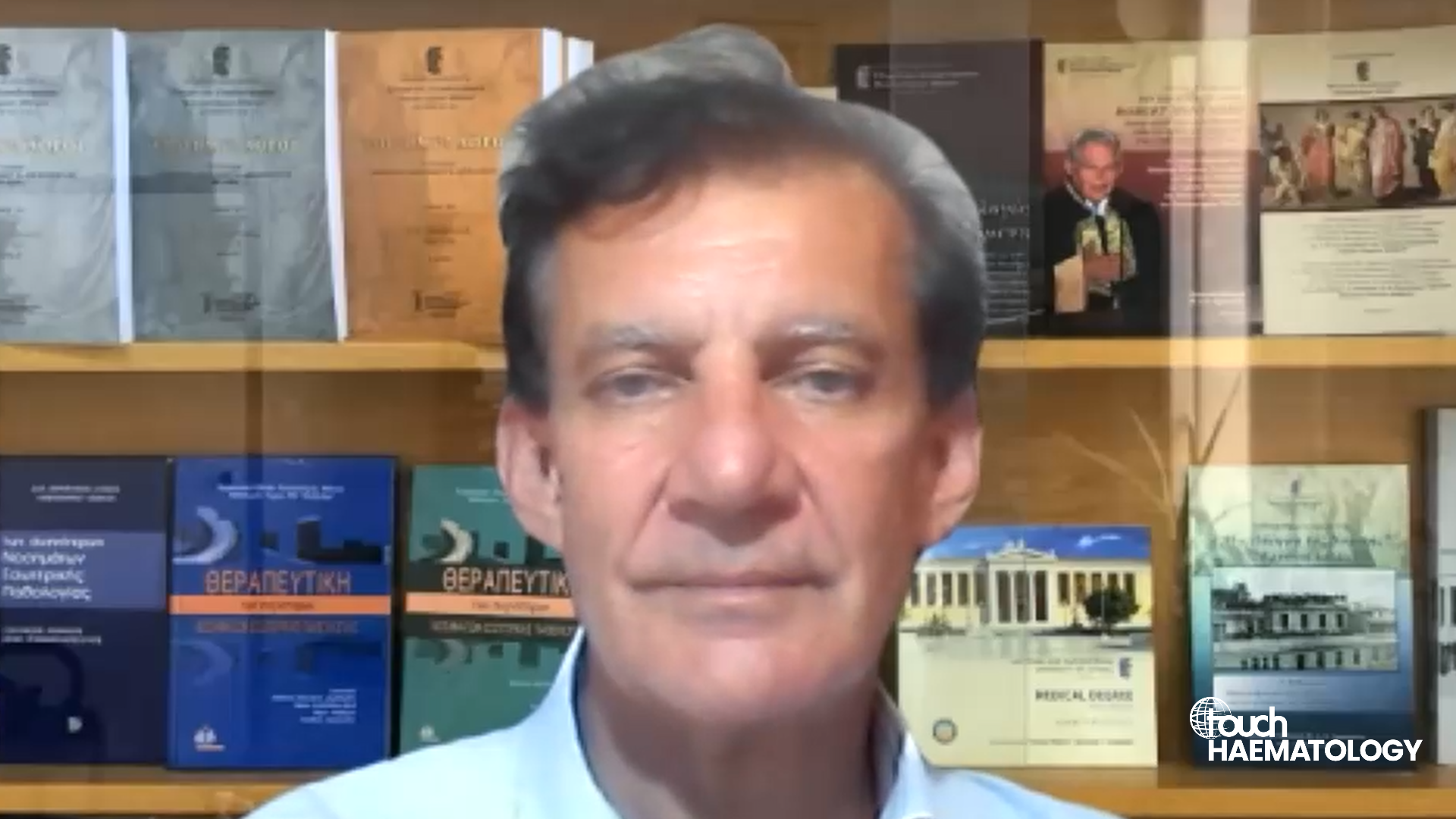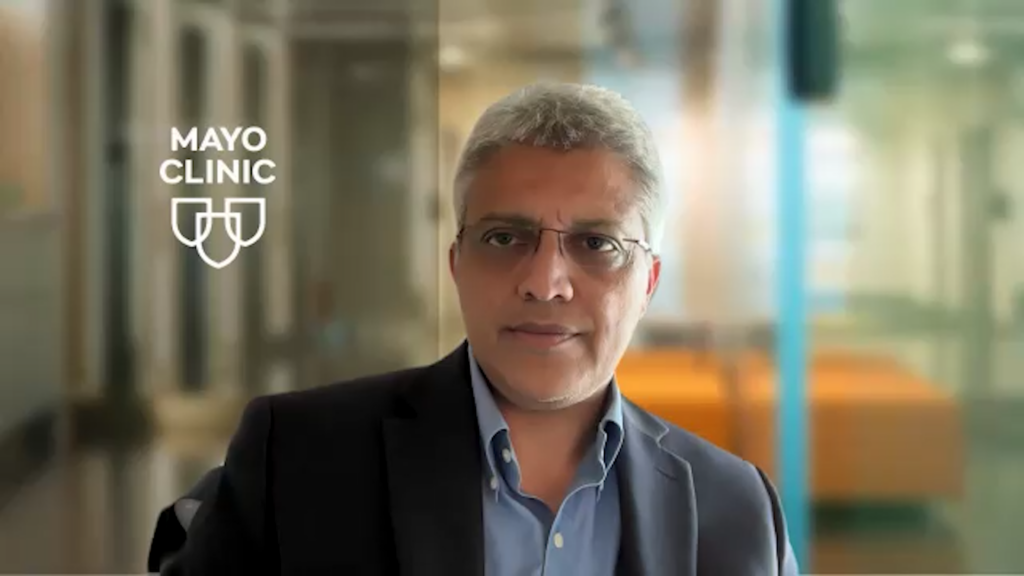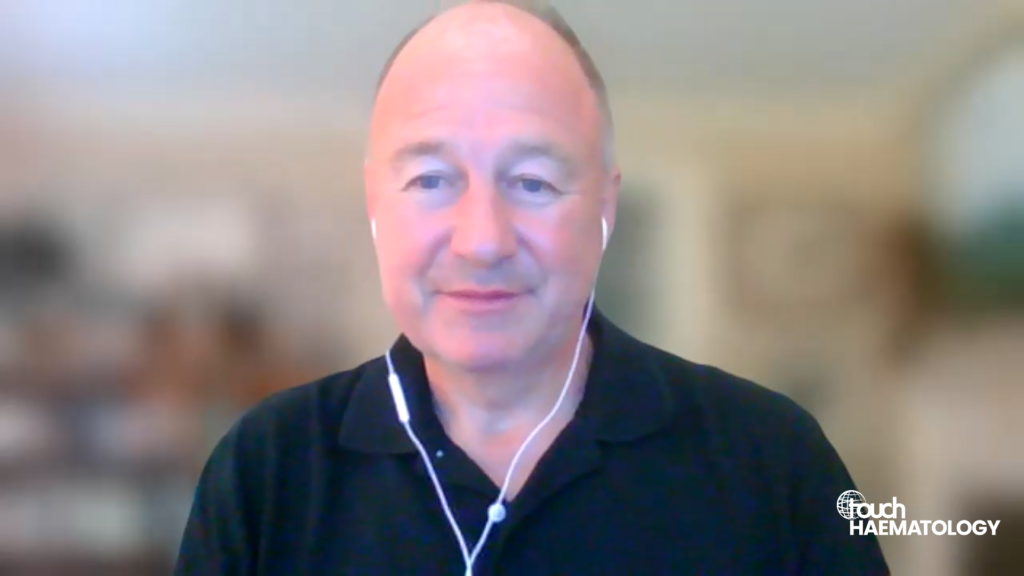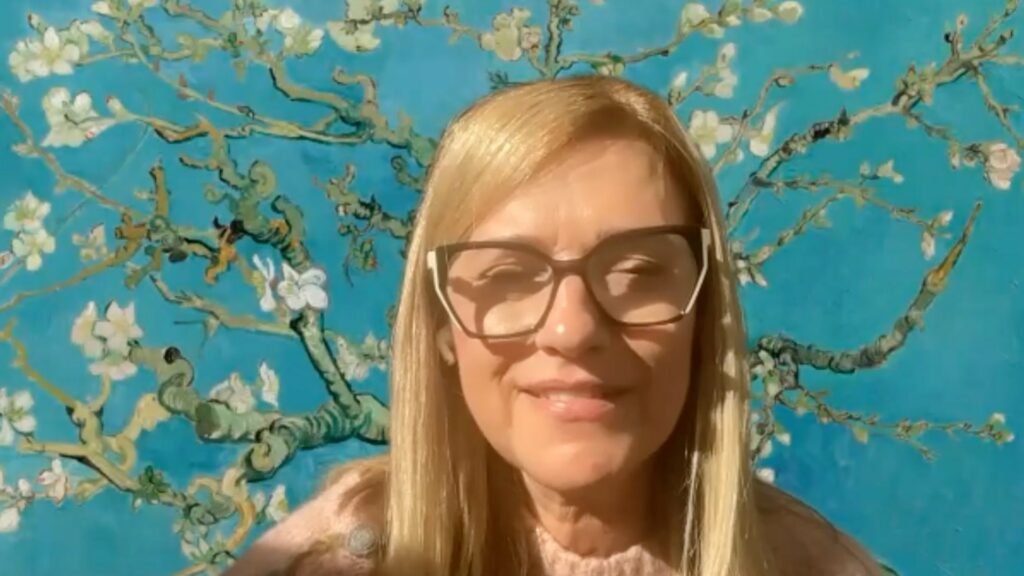touchHAEMATOLOGY coverage of data presented at EHA 2024:
The 29th European Hematology Association (EHA) 2024 Congress was held on 13–16th June 2024 in Madrid, Spain. As with every year, the EHA Congress covered a wide array of topics in haematology and haematological malignancies. Key data presented at the congress not only highlighted significant advancements in these areas but also provided insights that could shape future clinical practices.
Dr Shaji Kumar joins touchHAEMATOLOGY to discuss key topics and highlights from the congress in the multiple myeloma space.
Questions
- What were your highlights from EHA 2024 around multiple myeloma? (0:09)
- What are the unmet medical needs in multiple myeloma, and what research are you most looking forward to in the near future? (4:42)
References and associated abstracts
- Campelo MD, et al. Durable Clinical Benefit With Elritercept (KER-050) Treatment: Findings From An Ongoing Phase 2 Trial In Participants With Lower-Risk MDS. European Hematology Association (EHA) 2024 Annual Congress. Abstract S183.
- Costa LJ, et al. Efficacy And Safety Of Teclistamab In Patients With Relapsed/Refractory Multiple Myeloma With High-Risk Features: A Subgroup Analysis From The Phase 1/2 MAJESTEC-1 Study. European Hematology Association (EHA) 2024 Annual Congress. Abstract P923.
- Facon T, et al. Phase 3 Study Results Of Isatuximab, Bortezomib, Lenalidomide, And Dexamethasone (Isa-VRd) Versus VRd For Transplant-Ineligible Patients With Newly Diagnosed Multiple Myeloma (IMROZ). European Hematology Association (EHA) 2024 Annual Congress. Abstract S100.
- Krishnan AY, et al. MajesTEC-7: A Phase 3, Randomized Study of Teclistamab + Daratumumab + Lenalidomide (Tec-DR) Versus Daratumumab + Lenalidomide + Dexamethasone (DRd) in Patients with Newly Diagnosed Multiple Myeloma Who Are Either Ineligible or Not Intended for Autologous Stem Cell Transplant. Blood. 2022;140(Suppl. 1):10148–9. DOI: https://doi.org/10.1182/blood-2022-160173.
- Moreau P, et al. Daratumumab (DARA) + Bortezomib/Thalidomide/Dexamethasone (D-VTd) Followed By DARA Maintenance In Transplant-Eligible (TE) Newly Diagnosed Multiple Myeloma (NDMM): >6-Year Update Of CASSIOPEIA. European Hematology Association (EHA) 2024 Annual Congress. Abstract S204.
- Sonneveld P, et al. Daratumumab + Bortezomib/Lenalidomide/Dexamethasone In Transplant-Eligible Patients With Newly Diagnosed Multiple Myeloma: Analysis Of Minimal Residual Disease In The PERSEUS Trial. European Hematology Association (EHA) 2024 Annual Congress. Abstract S201.
Disclosures: Dr Shaji Kumar has received consultancy fees from AbbVie, Amgen, Antagene, AstraZeneca, Beigene, BMS, Genentech, GSK, Oncopeptides, and Sanofi; research funding from AbbVie, Amgen, AstraZeneca, Bayer, BMS, Carsgen, Celgene, Genentech, Genzyme, GSK, Janssen, Millennium, Novartis, Sanofi, and Takeda; and holds membership on a Board or Advisory Committee for Janssen and Takeda.
This content has been developed independently by Touch Medical Media for touchHAEMATOLOGY. It is not affiliated with the European Hematology Association (EHA). Views expressed are the speaker’s own and do not necessarily reflect the views of Touch Medical Media. Unapproved products or unapproved uses of approved products may be discussed by the faculty; these situations may reflect the approval status in one or more jurisdictions. No endorsement of unapproved products or unapproved uses is either made or implied by mention of these products or uses by Touch Medical Media or any sponsor. Views expressed are the speaker’s own and do not necessarily reflect the views of Touch Medical Media.
Abbreviations: CAR, chimeric antigen receptor; dara, daratumumab; MRD, minimal residual disease; PFS, progression-free survival; VRD, bortezomib, lenalidomide, dexamethasone; VTD, bortezomib, thalidomide and dexamethasone
Transcript:
Hi. My name is Shaji Kumar. I’m a haematologist at Mayo Clinic in Rochester, Minnesota.
Q. What were your highlights from EHA 2024 around multiple myeloma?
Both at ASCO and EHA this year, in 2024, we had a large amount of very exciting data that was presented both in terms of newly-diagnosed myeloma treatment strategy and also how we can use these immunotherapies in the relapse patient population.
Particularly in the setting of newly-diagnosed myeloma, in the transplant-eligible patient population, we saw updated data from the CASSIOPEIA trial that looked at daratumumab (dara), bortezomib, thalidomide, dexamethasone (VTD), in patients undergoing autologous stem cell transplant. As one may recall, the original trial demonstrated that adding daratumumab to the VTD triplet improved the progression-free survival in this patient population. Now this trial had a second randomization to daratumumab maintenance versus no maintenance. And amongst the four subgroups of patients with longer follow-up, again, we can clearly see that use of daratumumab both in induction and maintenance were associated with the higher MRD-negativity rate, and there was a trend towards better progression-free survival as well. However, this trial still does not clearly demonstrate overall survival difference between the use of daratumumab in these different settings. And moreover, daratumumab was used once every eight weeks in the dara-VTD [group].
We also saw some updates from the PERSEUS trial where they demonstrated higher rates of MRD negativity, particularly to the level of ten to the power of minus six with the use of dara-RVD combination for induction therapy and consolidation before and after transplant, and also daratumumab [lenalidomide] maintenance. This trial showed the continuing increase in the depth of response over time while patients are in maintenance therapy and also the increased duration of sustained MRD negativity amongst those getting the quadruplet induction and doublet maintenance. This is important data, but still does not completely give us the answer as to whether every patient who is getting a quadruplet induction therapy still needs daratumumab as part of maintenance.
Now, importantly, in the non-transplant eligible patient population, there was phase III data from the IMROZ trial that looked at a quadruplet versus a triplet, and a second phase III trial called the BENEFIT trial that also looked at a quadruplet versus triplet. In the IMROZ study, the comparison, again, was adding, isatuximab, a monoclonal antibody, to VRD backbone, whereas the BENEFIT trial was adding bortezomib to a isatuximab and lenalidomie-dexamethasone triplet. Both trials showed that there was an improvement in the depth of response with the four drug compared to third drug or three drug combinations. And in particular, the IMROZ trial showed significant improvement in the progression-free survival. It’s estimated that we might be looking at, again, about 6–8 year median PFS, in patients getting this quadruplet regimen. Again, these patients are between 65–80 years of age.
Of course, there was some increased toxicity: increased risk of infection with the quadruplet. So one has to be careful about which patients we select for it: the quadruplet regimen. But I think it’s reasonable to say that with this data, in the more fit patients who are not going to a stem cell transplant between the age of 65 and 80 should certainly be considered for the use of a quadruplet regimen that includes a anti-CD38 proteosome inhibitor and lenalidomide.
We also saw some additional analysis from the ongoing CAR T trials and the bispecific antibody trials, again reinforcing the significant activity of these agents in the relapse setting.
There are some data suggesting the increased use of these agents or future use of these agents in earlier lines. We saw the initial running cohort of the MajesTEC-7 study that looked at adding teclistamab as part of the initial therapy. And the results certainly appear to be quite interesting, but the concerns for toxicity persist.
We saw some results from the subanalysis of the […] trial, looking at patients who have functional high-risk disease and early-line of therapy again highlighting the efficacy, but still not providing all the necessary information as to how we might use it in clinical practice yet.
Q. What are the unmet medical needs in multiple myeloma, and what research are you most looking forward to in the near future?
Despite all the improvements in therapy patients with myeloma still continue to need additional therapy as the disease relapses. So I think developing new treatments, for relapsed/refractory disease is going to be important, and this should be based on biology.
Second, patients with high-risk disease still tend to do poorly despite all these improved treatments, and understanding both those at high risk at baseline based on genomics, as well as those [who have] functional high-risk disease based on how they behave subsequently, are all going to be an important part.
Certainly, I think, ongoing research looking at early intervention strategies in patients with high-risk monitoring is going to be important. So there are multiple areas where I think we can still continue to make significant progress in this disease and improve the outcome and survival of patients overall.
Interviewer/Editor: Helen Bowden
Cite: Kumar S. Multiple myeloma highlights at EHA 2024 with Dr Shaji Kumar. touchHAEMATOLOGY. July 29, 2024.





